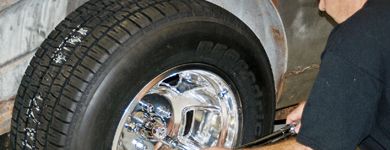
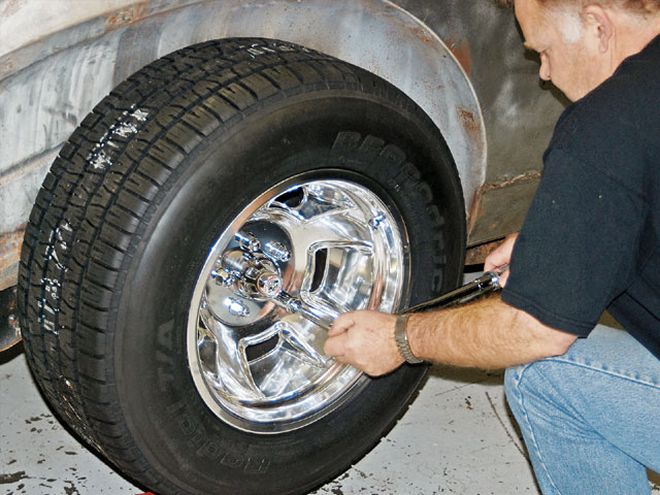
In the old days, it was pretty easy to pull a set of tire irons out of the bottom drawer of your toolbox and spoon a fresh set of skins over your wheels. Simple. Done deal. If you didn't own a set of spoons, or if you weren't inclined to do the job, you simply rolled the rubber over to the corner gas station and they mounted them up for you. Not so today. Things are different. Plenty of wheels are sophisticated. They're precise, some are very light, and many of them require special care in mounting. Tires are equally sophisticated. Radials have stiff sidewalls, and some have very short sidewalls, so using a set of spoons at home with these is likely out of the question. The reality is, wheels and tires just aren't as easy to mount properly as they were in the old days. In short, special care must be taken to mount and balance the combination.
There's more too. As rodding evolves, so does the array of hardware in use. Some cars use skinny 16- or 18-inch-diameter steel wheels; others use billet aluminum 20-inch-tall, 10-, 12-, or larger-width billet wheels. Others incorporate vintage cast-aluminum or even cast-magnesium wheels. As you can see in the accompanying photos, choices are definitely broad.
In the next installment, we'll take a close look at mounting and balancing street rod rolling stock, examining wheel studs and lug nuts in the process. We'll also take a very short peek at the (ugghh!) prospect of fixing flats on the road.
Wheeling & Dealing:
What Makes Up A Wheel?
As previously pointed out in this article, there are plenty of different wheels in use today-solid steel jobs, wires of various shapes and sizes, cast aluminum, cast magnesium, steel-aluminum composites, billet wheels, and so on. They all look different, and they're all constructed using different materials or methods, but they also share a number of similarities. They are, after all, automotive wheels. What follows is a detailed look at what makes up a wheel.
2.645" = 4 1/2" B.C. (normal later Ford pattern)
2.792" = 4 3/4" B.C. (normal Chevrolet or small GM passenger car pattern)
2.939" = 5" B.C. (normal older Olds-Pontiac or large GM passenger car)
3.233" = 5 1/2" B.C. (normal early Ford or Ford truck-also used on Top Fuel Dragster applications)
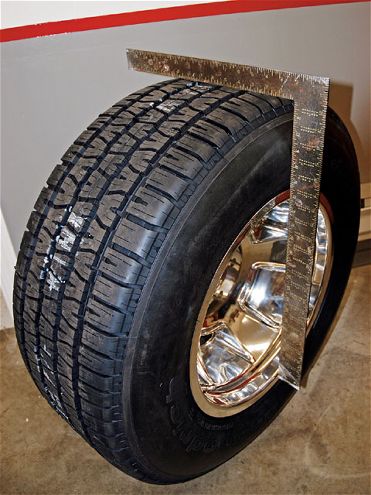
To measure installed width, simply drop a good old-fashioned carpenter's square over the tire. You can include the section width or "bulge" in the measurement. The tire manufacturers specify tire widths based upon a certain wheel width dimension. If the wheel width increases, then the overall section width increases. A good example is this BFGoodrich Radial T/A: The tire is a P285/60R16. BFG dimensional data for this tire shows a section width of 11.4 inches when mounted on an 8.5-inch-wide wheel. Mounted on a 16x10 Real Rodders Wheel, the tire has a bulge or section width dimension of just over 12 inches.
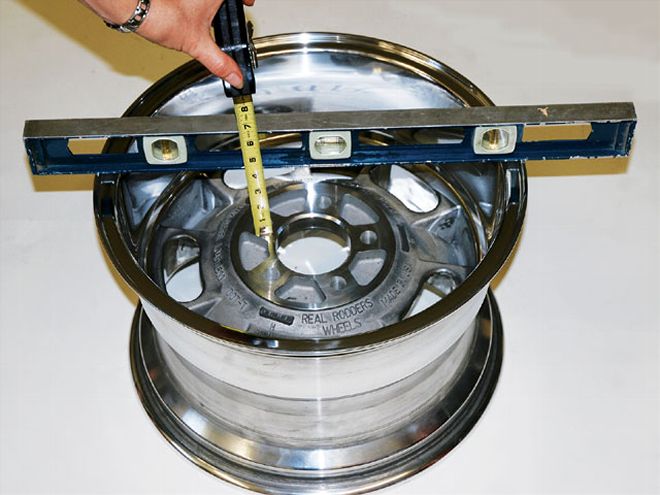
Backspace is an important dimension. It tells you how far the wheel is inset or, in other words, how much of the backside of the wheel hangs over the brake drum (or disc). To measure backspace, simply place a straightedge over the backside of the wheel lip and measure down to the wheel-mounting surface in the wheel center or hub. The thickness of the wheel lip will have an effect on the backspace dimension. Subtract the lip dimension for true backspace. You'll often hear the term "offset." Essentially, offset is based upon backspace, but there is a difference: The offset of a wheel is the distance from the hub-mounting surface to the centerline of the wheel. There are three types of offset. First, there's zero offset, where the hub-mounting surface is centered in the wheel. With positive offset, the hub-mounting surface is offset toward the curbside of the wheel. Good examples of positive offset are the wheels found on front-wheel-drive cars. The backspace dimension on these wheels is large. Then, with negative offset, the hub-mounting surface is offset toward the brake side of the wheel's centerline. Reverse wheels are typically a negative offset. The backspace dimension on these wheels is small.
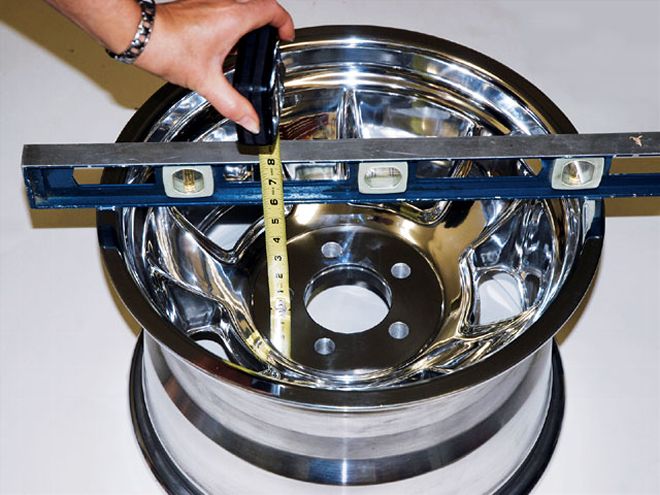
The curbside, or "wheel face," dimension is measured the same way as the backspace. Keep the thickness of the lip in mind and take it into consideration when working out the face dimension. The face dimension, added to the backspace dimension plus the thickness of the wheel mount flange (hub center) equals the wheel width. Face dimensions become critical when figuring out how much wheel and tire can fit on a given axle in a specific car.
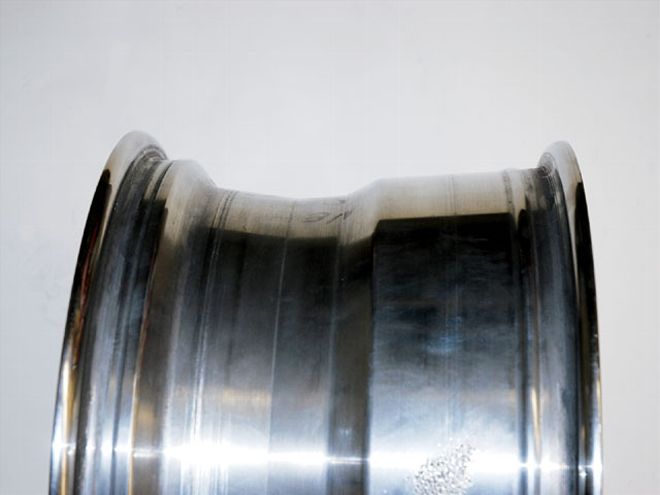
A term you'll sometimes come across when discussing wheels is the drop center. When viewed from this angle, the center of the wheel has a smaller diameter than the outside segments. The idea is to ease tire installation and removal on the wheel. When the tire is deflated, one of the beads can fall into the drop center. Note, too, that there are small raised lips or safety beads on the outboard side of the drop center. Those safety beads maintain the tire on the wheel if the car experiences a blowout or a flat.
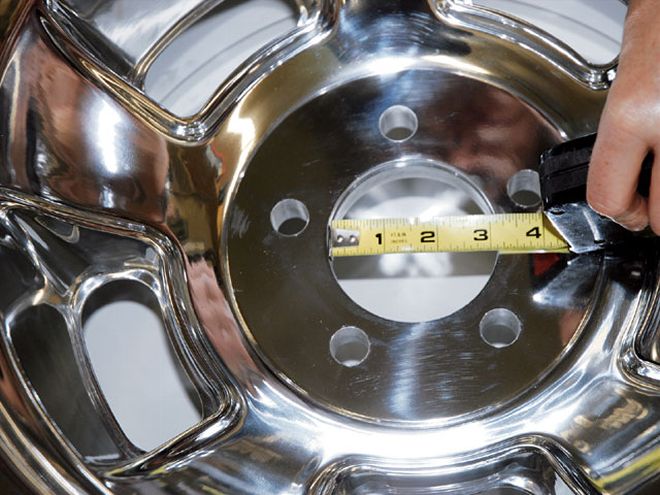
The register bore of the wheel center bore is the part where the hub passes through the wheel (at the mount flange). For some applications, this opening is machined to exactly match the hub. It is designed to precisely position and center the wheel while the lug nuts are torqued to spec. The accurate centering eliminates the chance of vibration from a wheel that isn't centered. In the cases where the wheels use precision-bored registers, the wheels are vehicle model specific. The wheel manufacturer will machine the register to the precise size specified by the car manufacturer (keep this in mind if you use a Corvette suspension system under your rod). There's more too: Most of the cars and wheels street rodders mess with incorporate non-hubcentric wheel register bores. The correct terminology is a "lug-centric" wheel. With these wheels you must torque the lug hardware with the vehicle off the ground (for example, on axle stands). This allows the nuts or bolts to center the wheel and then be torqued into place without the street rod weight pushing them off center.
Don't discount the size of the valve bore. There are two different sizes of valves commonly used today: 0.453-inch and 0.625-inch. There are several different types of high-quality valves available from companies such as Schrader-Bridgeport: snap-in (rubber), snap-in with chrome sleeve (rubber), clamp-in nickel (metal), high-performance clamp-in chrome (metal), and high-pressure snap-in (for applications up to 100 psi). When it comes to valve stems, though, it's buyer beware. Many offshore stems are constructed from natural rubber instead of EPDM (a stout synthetic rubber used in most quality valve stems). According to Schrader, EPDM has a much broader temperature range than natural rubber, and remains flexible in the coldest weather. It also resists ozone and chemical attack that deteriorates natural rubber. Another issue with offshore stems is the fact that natural rubber dries out, and they become brittle following a couple of years of service. The end result is unwanted leakage. Another consideration is the metal or high-performance stem (seen on the vintage Cragar Super Trick wheel in the photo below). These stems are engineered so they can withstand the highest of pressures (up to 130 psi). They bolt in and they're sealed by way of a pair of rubber grommets. Many race-sanctioning bodies mandate this style of air valve since it is more robust. You can usually find the manufacturer name somewhere on the stem. If not, be suspect of an inferior sweatshop product.
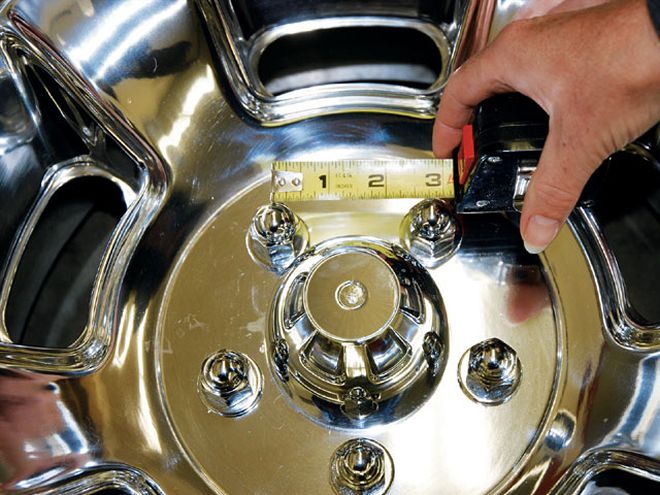
Most street rods incorporate some form of five-bolt wheel pattern. Typically, bigger means stronger when it comes to bolt patterns. Information from the old Summers Brothers axle manufacturing company indicates that a wheel stud on a 5.0-inch-diameter bolt circle carries 11 percent less force than an identically sized stud on a 4 1/2-inch-diameter bolt pattern. That's why Top Fuel race cars use the old Ford 5-on-5 1/2-inch pattern. If you don't know the bolt circle dimensions, try this tip from Mark Williams: Measure between the center of two adjacent wheel studs and reference the table below.